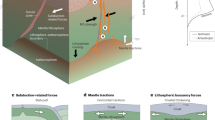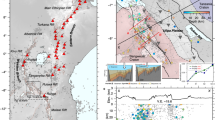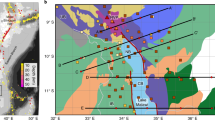Abstract
Although many continental rifts and passive margins are magmatic, some are not1. This observation prompted endmember views of the mechanisms driving continental rifting, where magma-rich or active rifts would be caused by deep mantle plumes2, whereas magma-poor or passive rifts would result from the stretching of the lithosphere under far-field plate forces3. The Central East African Rift provides a unique setting to investigate the mechanisms of continental rifting because it juxtaposes a magma-rich (eastern) branch and magma-poor (western) branch on either side of the 250-km-thick Tanzanian craton4. Here we investigate this contrasted behavior using a high-resolution rheologically consistent three-dimensional thermo-mechanical numerical model. The model reproduces the rise of a mantle plume beneath a craton experiencing tensional far-field stress. In our numerical experiments the plume is deflected by the cratonic keel and preferentially channelled along one of its sides. This leads to the coeval development of magma-rich and magma-poor rifts along opposite craton sides, fed by melt from a single mantle source. Our numerical experiments show strong similarities to the observed evolution of the Central East African Rift, reconcile the passive and active rift models, and demonstrate the possibility of developing both magmatic and amagmatic rifts in identical geotectonic environments.
This is a preview of subscription content, access via your institution
Access options
Subscribe to this journal
Receive 12 print issues and online access
$259.00 per year
only $21.58 per issue
Buy this article
- Purchase on Springer Link
- Instant access to full article PDF
Prices may be subject to local taxes which are calculated during checkout




Similar content being viewed by others
References
Buck, W. R. in The Treatise on Geophysics Vol. 6 (ed Watts, A. B.) (Elsevier, 2007).
Sengör, A. M. C. & Burke, K. Relative timing of rifting and volcanism on Earth and its tectonic implications. Geophys. Res. Lett. 5, 419–421 (1978).
McKenzie, D. Some remarks on the development of sedimentary basins. Earth Planet. Sci. Lett. 40, 25–32 (1978).
Saria, E., Calais, E., Stamps, D. S., Delvaux, D. & Hartnady, C. J. H. Present-day kinematics of the East African Rift. J. Geophys. Res. 119, 3584–3600 (2014).
Godfrey Fitton, J. Active versus passive continental rifting: Evidence from the West African rift system. Tectonophysics 94, 473–481 (1983).
Foulger, G. R. & Hamilton, W. B. Earth science: Plume hypothesis challenged. Nature 505, 618 (2014).
Whitmarsh, R. B., Manatschal, G. & Minshull, T. A. Evolution of magma-poor continental margins from rifting to seafloor spreading. Nature 413, 150–154 (2001).
Ritsema, J., van Heijst, H. J. & Woodhouse, J. H. Complex shear wave velocity structure imaged beneath Africa and Iceland. Science 286, 1925–1928 (1999).
Nyblade, A. A., Owens, T. J., Gurrola, H., Ritsema, J. & Langston, C. A. Seismic evidence for a deep upper mantle thermal anomaly beneath east Africa. Geology 28, 599–602 (2000).
Satsukawa, T. et al. Seismic anisotropy of the uppermost mantle beneath the Rio Grande rift: Evidence from Kilbourne Hole peridotite xenoliths, New Mexico. Earth Planet. Sci. Lett. 311, 172–181 (2011).
Calais, E. et al. Strain accommodation by slow slip and dyking in a youthful continental rift, East Africa. Nature 456, 783–787 (2008).
Kendall, J. M., Stuart, G. W., Ebinger, C. J., Bastow, I. D. & Keir, D. Magma-assisted rifting in Ethiopia. Nature 433, 146–148 (2005).
Rooney, T. O., Herzberg, C. & Bastow, I. D. Elevated mantle temperature beneath East Africa. Geology 40, 27–30 (2012).
Ferguson, D. J. et al. Melting during late-stage rifting in Afar is hot and deep. Nature 499, 70–73 (2013).
Burov, E., Guillou-Frottier, L., d’Acremont, E., Le Pourhiet, L. & Cloetingh, S. Plume head–lithosphere interactions near intra-continental plate boundaries. Tectonophysics 434, 15–38 (2007).
Lithgow-Bertelloni, C. & Silver, P. G. Dynamic topography, plate driving forces and the African superswell. Nature 395, 269–272 (1998).
Moucha, R. & Forte, A. M. Changes in African topography driven by mantle convection. Nature Geosci. 4, 707–712 (2011).
Yang, Z. & Chen, W. P. Earthquakes along the East African Rift system: A multiscale, system-wide perspective. J. Geophys. Res. 115, B12309 (2010).
Nyblade, A. A. Heat flow across the East African plateau. Geophys. Res. Lett. 24, 2083–2086 (1997).
Roberts, E. M. et al. Initiation of the western branch of the East African Rift coeval with the eastern branch. Nature Geosci. 5, 289–294 (2012).
Chesley, J. T., Rudnick, R. L. & Lee, C. T. Re–Os systematics of mantle xenoliths from the East African Rift: Age, structure, and history of the Tanzanian craton. Geochim. Cosmochim. Acta 63, 1203–1217 (1999).
Adams, A., Nyblade, A. & Weeraratne, D. Upper mantle shear wave velocity structure beneath the East African plateau: Evidence for a deep, plateau-wide low velocity anomaly. Geophys. J. Int. 189, 123–142 (2012).
Pik, R., Marty, B. & Hilton, D. R. How many mantle plumes in Africa? The geochemical point of view. Chem. Geol. 226, 100–114 (2006).
Halldórsson, S. A., Hilton, D. R., Scarsi, P., Abebe, T. & Hopp, J. A common mantle plume source beneath the entire East African Rift system revealed by coupled helium-neon systematics. Geophys. Res. Lett. 41, 2304–2311 (2014).
MacDonald, R., Rogers, N. W., Fitton, J. G., Black, S. & Smith, M. Plume–lithosphere interactions in the generation of the basalts of the Kenya Rift, East Africa. J. Petrol. 42, 877–900 (2001).
Gerya, T. V. & Yuen, D. A. Robust characteristics method for modelling multiphase visco-elasto-plastic thermo-mechanical problems. Phys. Earth Planet. Inter. 163, 83–105 (2007).
Ebinger, C. J. & Sleep, N. H. Cenozoic magmatism throughout east Africa resulting from impact of a single plume. Nature 395, 788–791 (1998).
Davis, P. M. & Slack, P. D. The uppermost mantle beneath the Kenya dome and relation to melting, rifting and uplift in East Africa. Geophys. Res. Lett. 29, 1117 (2002).
Spath, A., Le Roex, A. P. & Opiyo-Akech, N. Plume-lithosphere interaction and the origin of continental rift-related alkaline volcanism—the Chyulu Hills Volcanic Province, southern Kenya. J. Petrol. 42, 765–787 (2001).
Sleep, N. H., Ebinger, C. J. & Kendall, J. M. Deflection of mantle plume material by cratonic keels. Spec. Publ. Geol. Soc. (Lond.) 199, 135–150 (2002).
Gerya, T. V. Introduction to Numerical Geodynamic Modelling 221–240 (Cambridge Univ. Press, 2010).
Acknowledgements
This study is co-funded by a US National Science Foundation grant EAR-0538119 to E.C., the Advanced ERC Grant 290864 RHEOLITH to E.B., the INSU-CNRS, a UPMC Invited Professor Grant (T.G.) and an ETH Invited Professor Grant (E.B.). Numerical simulations were performed on the ERC-funded SGI Ulysse cluster of ISTEP.
Author information
Authors and Affiliations
Contributions
A.K., E.B. and E.C. designed the study. A.K. conducted 3D experiments. E.B. conducted 3D test experiments and designed the conceptual model. E.C. and S.L. provided geophysical and geologic context. T.G. designed the 3D thermo-mechanical code and conducted test experiments. All authors discussed the results and implications and commented on the manuscript at all stages.
Corresponding author
Ethics declarations
Competing interests
The authors declare no competing financial interests.
Supplementary information
Supplementary Information
Supplementary Information (PDF 1593 kb)
Rights and permissions
About this article
Cite this article
Koptev, A., Calais, E., Burov, E. et al. Dual continental rift systems generated by plume–lithosphere interaction. Nature Geosci 8, 388–392 (2015). https://doi.org/10.1038/ngeo2401
Received:
Accepted:
Published:
Issue Date:
DOI: https://doi.org/10.1038/ngeo2401
This article is cited by
-
Blind magmatism abets nonvolcanic continental rifting
Communications Earth & Environment (2024)
-
Role of Large Igneous Provinces in continental break-up varying from “Shirker” to “Producer”
Communications Earth & Environment (2024)
-
Progress in the numerical modeling of mantle plumes
Science China Earth Sciences (2023)
-
Interpretation of gravity–magnetic anomalies to delineate subsurface configuration beneath east geothermal province along the Mahanadi rift basin: a case study of non-volcanic hot springs
Geothermal Energy (2022)
-
Plume–MOR decoupling and the timing of India–Eurasia collision
Scientific Reports (2022)



